FEMTO-LASIK - THE MODERN, SAFE AND INDIVIDUAL EYE LASER PROCEDURE
WHAT IS FEMTO-LASIK?
The EuroEyes LASIK method is one of the most modern, safe and individualized procedures to correct nearsightedness, farsightedness or astigmatism. We combine two of the most advanced and precise technologies: wavefront analysis and Femto-LASIK.
Since each eye has very individual characteristics – as unique as a fingerprint – a method is needed that adapts to the eye. With the combination of wavefront analysis and Femto-LASIK, an innovative and revolutionary treatment method is available to you.
The top doctors at EuroEyes, awarded by the magazine FOCUS, thus help you to achieve excellent vision quality. Highly precise and absolutely blade-free!
*The actual costs of a laser eye procedure can only be accurately determined after an extensive preliminary examination – these depend on factors such as visual impairment, thickness of the cornea or the procedure used. EuroEyes can only assess which eye laser procedure is suitable for the patient and what the costs will be after the initial consultation and the findings of the preliminary examination.

HOW DOES FEMTO-LASIK WORK AT EUROEYES?
Cornea analysis
Wavefront analysis creates an individual image of the corneal surface. This analysis is incorporated into the treatment and thus creates a specified correction.
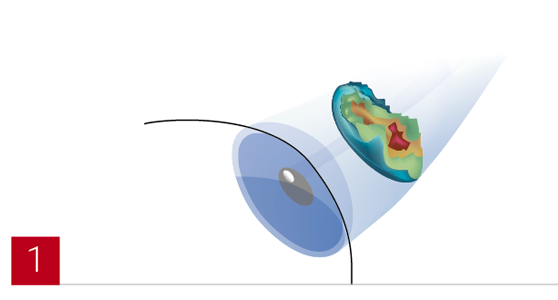
Femtosecond laser
The corneal flap is prepared with the femtosecond laser in a way that is gentle on the tissue. The laser treats each eye individually, working with high precision and uniformity.
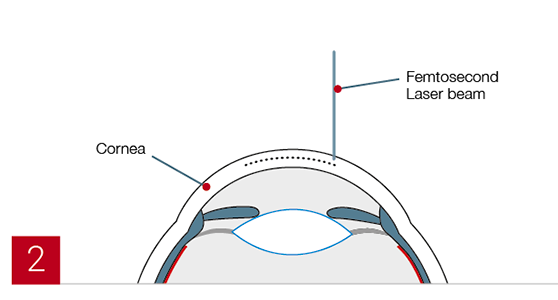
Excimer Laser
Based on the wavefront analysis data – the fingerprint of the eye – the excimer laser corrects your refractive error and models the cornea.
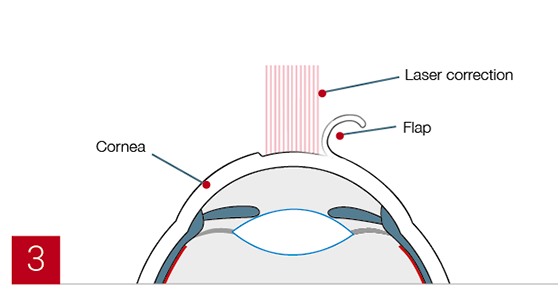
Rehabilitation
The flap is then folded back again. It adheres again by itself due to internal bonding forces and protects like the body’s own plaster.
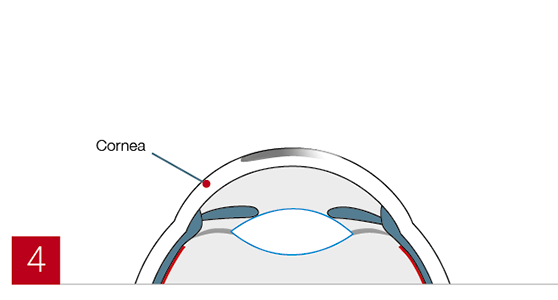
ADVANTAGES OF FEMTO-LASIK
Combination of Femto-LASIK and Wavefront Analysis
For the patient it is one of the best possible treatment methods with decisive advantages:
The personalized treatment among laser eye surgery methods
Consideration of the very specific eye characteristics
correction of refractive errors as precisely as is hardly possible with glasses and contact lenses
Better visual acuity, better contrast vision and better night vision
More safety and higher precision
No blade: LASER instead of knife
Painless and quick procedure
Treatment of higher refractive errors
Treatment of low corneal thickness
Revolutionary procedure: improves the quality of vision
During Femto-LASIK with wavefront analysis, all the data obtained is taken into account individually: From the wavefront map, it is possible to deduce exactly in which area of the cornea how much tissue needs to be removed or lasered. In this way, EuroEyes not only corrects your refractive error, but also improves your quality of vision by compensating for your aberrations. EuroEyes-LASIK means customized correction and high quality treatment for you.
THE FEMTO-LASIK TREATMENT PROCEDURE
1. The personal consultation about your LASIK method
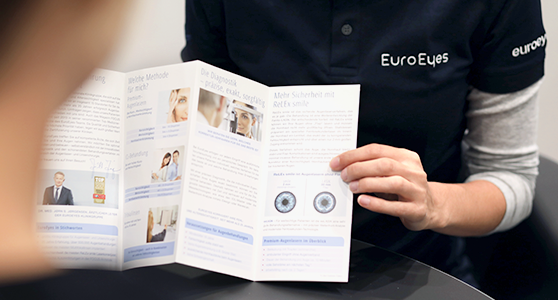
Measurement of your eyes
Checking whether your eyes are suitable for Femto-LASIK with or without wavefront analysis
Clarification of the costs of your individual LASIK treatment
2. The intensive preliminary medical examination
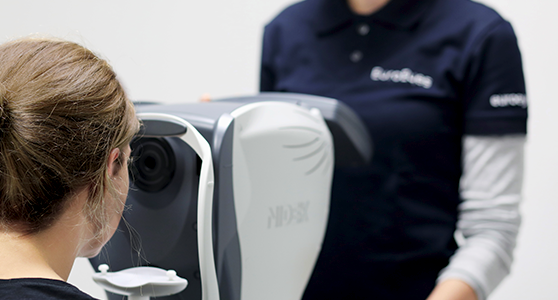
Examination time approx. 2 hours
Comprehensive preliminary ophthalmological examination and measurement of your eyes
Detailed explanation by a specialist in ophthalmology
Please do not wear soft contact lenses for one week and hard contact lenses for two weeks before this appointment
After the examination you are not allowed to drive any vehicle – neither car, nor motorcycle or bicycle. Please use public transportation or a cab
You will receive an aftercare kit for the days following your treatment. The contents and medications will be explained to you in detail by our staff
3. On the day of your Femto-LASIK treatment
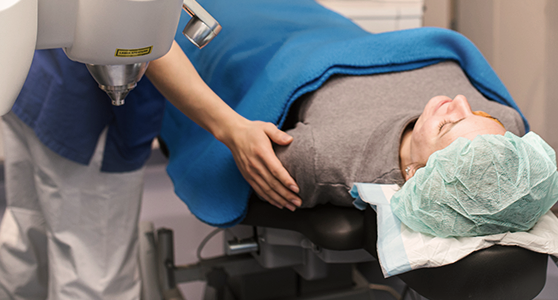
We recommend that you dress comfortably
You can eat and drink regularly, but please do not smoke
For hygiene reasons, it is important that you wash your face thoroughly before the treatment, remove make-up completely and avoid perfume
You will receive anesthesia with eye drops
Outpatient procedure: no eye bandage is necessary, sunglasses recommended
Total duration of the treatment (both eyes): Approx. 25 minutes
after the treatment you are not allowed to drive a vehicle
4. After the Femto-LASIK treatment

Please do not rub your eyes
Antibiotic eye drops 6× / day for 1 week
Artificial tears as needed
Professional activity after 2-3 days
Sports activities after approx. 3 days, swimming and sauna after approx. 2 weeks
Controls: after 1 day – 1 week – 1 month
Driving a car is allowed again only after the doctor’s permission, usually at the weekly check-up
INTERESTING FACTS ABOUT FEMTO-LASIK
Femto-LASIK is the further development of classic LASIK and is one of the most precise procedures for the correction of refractive errors.
Why does EuroEyes only use Femto-LASIK instead of microkeratome LASIK?
LASIK (laser in situ keratomileusis) has been a scientifically recognized and established procedure for the correction of refractive errors for many years and is therefore one of the preferred surgical methods of many eye specialists worldwide.
This classic LASIK method has been decisively further developed in recent years: to Femto-LASIK.
In order to correct a refractive error with LASIK, or Femto-LASIK, a small, round corneal flap must first be prepared. The preparation of this corneal flap, also called flap, is done with a micrometer in classic LASIK. In Femto-LASIK, a femtosecond laser prepares the flap – completely without the use of mechanical cutting instruments.
Safety and precision with the femtosecond laser
Femto-LASIK is a precise procedure for creating the corneal flap. Therefore, when choosing a clinic, always make sure that a femtosecond laser is used for laser eye treatment with a flap.
The advantages of Femto-LASIK compared to classic LASIK at a glance:
This speaks for the Femto-LASIK:
smooth, even corneal flaps
thinner flaps, less tissue removal
more precise and safe method
painless method, “gentle Lasik”
gentle, gentler method
faster vision rehabilitation
shaped contact lens
no miscuts during the surgery
no black-out of the eye
no interruption of the retinal blood flow
This speaks against the Mikrokeratom LASIK:
irregularly shaped corneal flaps
more stress on the cornea due to thicker flaps
unsafe method, deviations in flap thickness
unpleasant to painful
increased stress for the eye due to micrometer
longer side effects like dry eye
suction ring
incorrect incisions possible during surgery
black-out of the eye
interruption of retinal blood flow possible
The femtosecond laser - technical facts
A femto-laser is an infrared light laser that treats tissue such as the cornea not only very precisely, but also with much less heat than other lasers. This proves to be a decisive advantage, especially in eye surgery. The femtosecond laser works on the basis of ultra-short light pulses. These last only fractions of a billionth of a second; their spot size is only 1/100 mm.
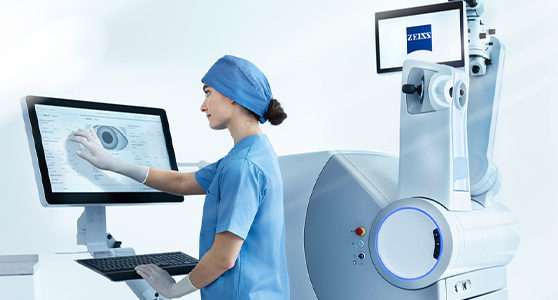
The VisuMax femtosecond laser
A specially developed laser system, the VisuMax femtosecond laser from Carl Zeiss, is used for ReLEx treatment. This laser has already proven itself in Femto-LASIK procedures with its sophisticated technology, precision and reliability. Through corresponding further development, it now makes it possible for the first time to prepare a lenticule within the intact cornea with millimeter precision, so that larger incisions and a flap can be dispensed with.
The surrounding corneal tissue is spared as much as possible and the visual defect can be corrected in a targeted manner. A particular advantage of femtosecond technology, in addition to its high precision, is that it is highly reproducible and accurately predictable even when high corrections are involved.
In order to avoid unnecessary compression of the cornea, a contact lens is used that is adapted to the individual corneal anatomy and allows a precisely fitting treatment. This also avoids short-term visual loss, which can be caused by excessive intraocular pressure.
In addition to state-of-the-art laser technology, a functionally sophisticated and ergonomically shaped patient couch has also been developed for ReLEx treatments, allowing for maximum comfort and the most relaxed position possible during the procedure. During the operation, the patient’s position is continuously monitored and can be automatically readjusted if necessary.
WAVEFRONT ANALYSIS - WITH THE "IDESIGN" DIAGNOSTIC DEVICE
Acquiring your very own individual eye profile with “iDesign
With the help of aberrometer/wavefront technology, the individual characteristics of the eye or genetic fingerprint of the eye can be precisely determined. An aberrometer measures the refractive power of the eye – and thus existing irregularities that create aberrations – at several hundred points. EuroEyes uses the latest and most advanced aberrometry technology in this field with the iDesign diagnostic device.
Unlike previous devices, the iDesign Aberrometer measures the refractive power of the eye at a total of 1,250 points. All measured values are recorded graphically. This creates a kind of three-dimensional, personalized map that precisely indicates the refractive power for each point of the eye. Based on this “genetic fingerprint of the eye”, the laser can perform a person-specific, individualized treatment. In this way, the refractive errors of the entire eye are corrected with a degree of precision that is hardly possible with glasses or contact lenses. These aberrations can neither be detected nor corrected with a simple eyeglass lens determination. Since a classic LASIK is based on a spectacle lens determination, additional aberrations cannot be corrected with this treatment method. This is one of the reasons why EuroEyes has not performed this type of treatment for several years.
The “fingerprint of the eye”
Each person’s eye is unique in its structure and refractive power and thus as unique as a genetic fingerprint. Due to the individual nature of the cornea and lens, the human eye does not represent a perfect optical system. In a perfect optical system, for example, the cornea is uniformly and roundly shaped.
In reality, the cornea often has different curvatures at different points and various manifestations of aberrations. Therefore, each eye – even with the same refractive error of, for example, -3.5 Dpt – is individual, unique and different. For this reason, laser eye treatment should be carried out with biometrically personalized data, which individually corrects the total refractive power of each eye as precisely as is hardly possible with glasses or contact lenses.
The advantages of wavefront analysis
The revolutionary procedure improves the quality of vision. In wavefront-assisted femto-LASIK, all data obtained during aberrometry are individually taken into account: From the wavefront map, it is possible to deduce exactly in which area of the cornea how much tissue must be removed or lasered. In this way, EuroEyes not only corrects your refractive error, but also improves your quality of vision by compensating for your aberrations. The use of this revolutionary procedure in combination with the most advanced technology, offers EuroEyes patients the following treatment benefits:
Better quality of vision
Compensation of aberrations
Better visual acuity
Better contrast vision
Better night vision
Correction of complicated refractive errors
No other method can achieve such customized correction and treatment quality.
REQUIREMENTS FOR A FEMTO-LASIK TREATMENT
Minimum age 18 years
Sufficient thickness of the cornea
the refractive error should not have changed more than about 0.5 diopters in the last 2 years
the treatment should not be performed during pregnancy and lactation period
no eye diseases (e.g. keratoconus)
FREQUENTLY ASKED QUESTIONS ABOUT FEMTO-LASIK
A minimum age of 18 years is required for laser eye treatment.
Your values should be stable for about one year before treatment. If in doubt, come to us and we will check your visual acuity conscientiously.
Usually, the day after LASIK you can already see 80-90% of what you could see before with your visual aids and within 3 days you will have full visual acuity.
EuroEyes pays the utmost attention to maintaining high standards of quality and hygiene, which means that the complication rate for laser vision correction is extremely low. Real complications are extremely rare. In order to achieve an optimal healing process, it is very important that patients conscientiously keep their follow-up appointments. It is also essential to follow the drop schedule and the instructions given to the patient by the staff for the time after the treatment. The side effects that can occur during laser vision correction are usually short-term and harmless and treatable until full recovery.
After about two weeks, endurance sports are possible again without restrictions. Eye make-up, swimming or sauna are recommended in moderation, after about three to four weeks.
The costs depend on the amount of ametropia and the size of the corneal curvature.
Femto-LASIK treatment at EuroEyes is possible for as little as 1,900 euros per eye for up to -3 dpt. For more severe ametropia or hyperopia, the cost is 2,050 euros per eye.
You will receive an exact cost breakdown after a thorough preliminary examination. During the non-binding suitability check, all information necessary to list the specific costs for your LASIK treatment will be gathered. This ensures that you know the costs to be expected in your case before you decide on treatment at EuroEyes.
For more information on financing options, please contact our Service Center: +49 40 348 09 29 0
An alternative procedure to LASIK is the ReLEx smile procedure, which is even suitable for patients with higher refractive errors, thinner corneas or dry eyes. Nearsightedness up to -10 diopters can be treated with the ReLEx smile procedure. In the case of LASIK according to the EuroEyes procedure, treatment is only recommended up to a maximum of -8 diopters. A thinner cornea is also not a problem, because the cornea is not unnecessarily stressed with the ReLEx smile procedure and the tissue removal is significantly less. And since the nerves in the uppermost layer of the cornea, which are necessary for regulating the tear film, are largely preserved, the risk of dry eyes after the operation is also significantly reduced.
About EuroEyes
The EuroEyes clinic group is a globally successful company that was founded more than 30 years ago in Hamburg, Germany, where it is still headquartered today. In addition to locations throughout Germany, EuroEyes is also represented in China and Denmark and England. The company offers patients the entire spectrum of refractive surgery to correct refractive errors. Using state-of-the-art laser eye and lens surgery procedures, EuroEyes treats more than 25,000 patients annually with nearsightedness, farsightedness, astigmatism, presbyopia or cataracts. Each of our experienced top doctors performs more than 1,000 eye operations every year. In total, with more than 1,000,000 treatments, we have enabled our patients to live with freedom without glasses and contact lenses.Follow us on social media:





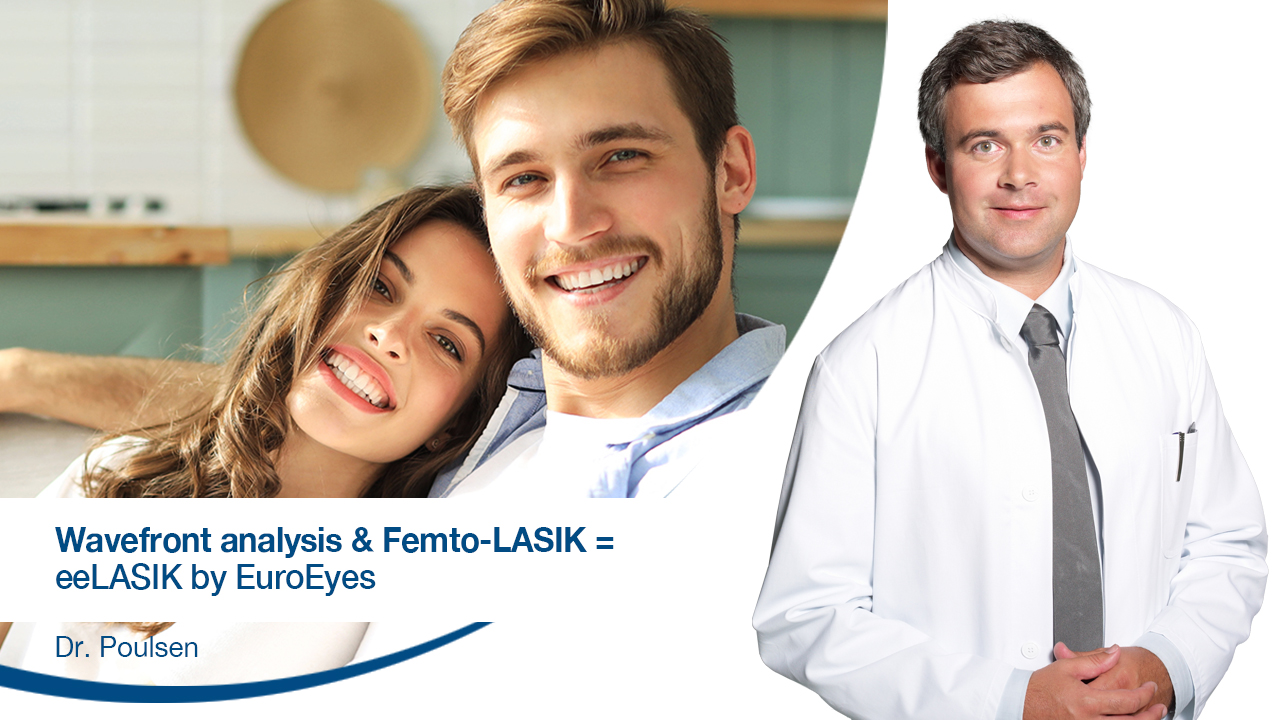


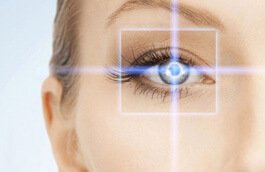

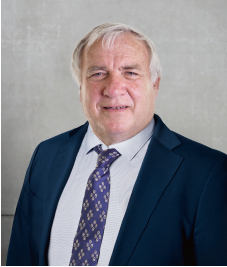



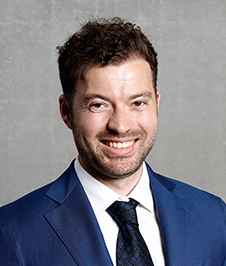
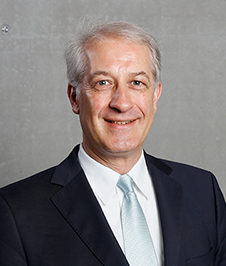




Join our Newsletter